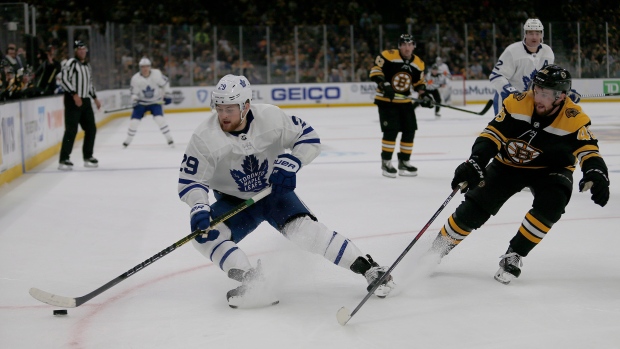Apr 15, 2019
Matchups have been the story so far in Leafs-Bruins series
Bruins coach Bruce Cassidy had a plan to neutralize the Leafs’ skill and speed in Boston, Travis Yost writes. With the series shifting to Toronto, it’s time to see what Mike Babcock has as a counter.
By Travis Yost

It is always interesting to see how the narrative in sports can shift by mere recency. If you would have told most Maple Leafs fans that they would get out of Boston having flipped home ice, everyone would have signed up for it. But the way they split those games – and the beating the Leafs took in Game 2 – has caused a bit of panic in Toronto.
That concern is understandable. Boston didn’t just win going away in Game 2, they were able to slow down most Leafs attackers on a shift-by-shift basis. That was always the worry with this matchup for Toronto – that the Bruins were one of the few teams across the entire National Hockey League with the talent and structure to harass Toronto’s skill players, taking the youth and speed advantage away.
One of the interesting aspects of the opening pair of games in Boston was how Bruins coach Bruce Cassidy managed his matchups. We learned an awful lot about what the Boston coaching staff felt was the right mix for deployment against the high- scoring Leafs.
On the Bruins side of the fence, Cassidy has been relatively consistent with his defensive pairings. Charlie McAvoy and Zdeno Chara have had the lion’s share of 5-on-5 minutes, with Brandon Carlo and Torey Krug getting the other piece of those top-four minutes. The Bruins have generally rotated Matt Grzelcyk and Connor Clifton in on the third pair.
Once the pairings formed, the matchups became targeted in nature. You can see the distribution in usage was very consistent over the first two games:
There are two big takeaways here. The first is the more obvious one – Cassidy made a concerted effort to keep his third pairing in more sheltered minutes, far away from the likes of the John Tavares and Auston Matthews lines. The Grzelcyk-Clifton duo generally saw Toronto’s third line and did admirable in those minutes.
The second? It sure seems as though Cassidy consistently used Chara and McAvoy against the Tavares line, and Krug and Carlo against the Matthews line. I think Boston also did this strategically. The Tavares line carries the most bona fide hockey skill and offensive prowess, whereas the Matthews line (especially with the likes of Kasperi Kapanen and Andreas Johnsson on the wings) is really speed-driven.
To me, this is a bit about keeping Chara away from Toronto’s most agile wingers – the type of attackers who are most likely to give the big Slovak defensive zone problems – and a bit about effectively neutralizing Toronto’s most skilled trio. Take away a bit of the speed advantage and Chara becomes his usual impenetrable self.
But it’s not like Chara and McAvoy are without some assistance. The hard matching we saw in the first two games also included the forward groups. Look at Boston’s internal combination mixing and you can see a concerted strategy to load up on talent against the Tavares line:
Cassidy gets his best pairing out frequently with his best two-way line on his team in Brad Marchand, Patrice Bergeron and David Pastrnak. That is a tall order for any line, even the likes of a line featuring two elite scorers in the aforementioned Tavares and Mitch Marner. (You can also see that Cassidy will also look for spot opportunities to get his best pairing out against weaker competition, often marrying them up with his fourth line.)
That leaves a rotating defensive pairing with the David Krejci line to take on Toronto’s middle-six scorers. There is heightened risk in these minutes – any time you are putting mid-tier talent up against the likes of Auston Matthews, you are asking for trouble. But with so many capable scorers at Toronto’s disposal, Boston has to choose the lesser of evils. So far, Cassidy’s plan has been to slow down the skill line with defensive talent and power, leaving his speedier depth players to take on the Matthews, et al. challenge.
Even though the Bruins split the games in Boston, you have to like a lot about what they did – especially at 5-on-5. Not a single Bruins defender is in the red when it comes to shot plus-minus, and only Chara was in the red from a scoring chance perspective (47 per cent, per Natural Stat Trick). The forwards show similarly – Danton Heinen and Bergeron are the only Bruins forwards in the red on the shots, and only Karson Kuhlman and Marchand are in the red when it comes to scoring chances. Notably, the Tavares line has only been on the ice for one goal for in the first two games, which suggests that the strategy may be working on that front.
Now comes the fun part. With games three and four back in Toronto, Mike Babcock gets last change and the ability to shape matchups his way. Does he roll best against best, or does he look for opportunities to flip the matchups Cassidy tried out this week?
The one thing I’m keeping an eye on: What things can Babcock throw at Boston’s top pairing (and specifically Chara) to make them a feel a little bit more uncomfortable? I suspect we might see a bit more of Matthews and company in the head-to-head, but we’ll have to wait until Monday night to find out.


